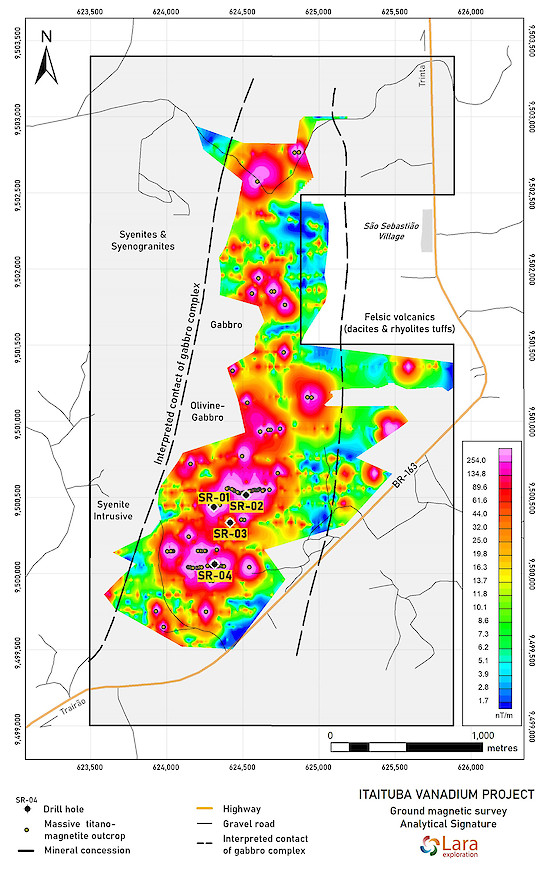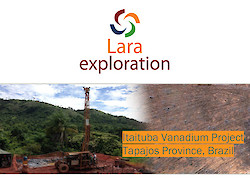Itaituba Vanadium Project
The Itaituba Vanadium Project is in the Tapajos District of northern Brazil, where Lara has completed surface mapping, sampling, geophysics and drilling after discovering massive vanadium-bearing magnetite sill-like bodies within a gabbro intrusive complex. Project work initially focused on vanadium-bearing magnetite bodies, but the more recent work has shown that the host gabbros also contain zones of enrichment in disseminated vanadium-bearing magnetite that can be concentrated to give a magnetic concentrate enriched in vanadium grade at approximately 1% V2O5. The ground magnetic survey suggests that the magnetite-rich gabbro units are extensive within the property.
Half core samples from four scout holes were subjected to Davis Tube Recovery (“DTR”) testing and the resulting magnetic concentrates then assayed for vanadium pentoxide (“V2O5”) content. In the fresh rock sections of three of the holes (holes SR-02, SR-03 and SR-04), significant intervals were identified, where the magnetite concentrate recovery values are in the order of 10 to 20% of the original core sample mass. In two of these holes (SR-03 and SR-04) the V2O5 grades for these concentrates are in the order of 0.8% to 1.1% (see table below). The hole SR-04 has the thickest interval of 47.65m and is still open to depth. The down hole intervals are assumed to be approximately true width, based on the surface mapping information and the drill core logging.
| DRILL HOLE | E-UTM | N-UTM | From (m) | To (m) | Width (m) | DTR Magnetic fraction recovery (%) | V2O5 in magnetic concentrate (%) |
| SR-01 | 624356 | 9500481 | No significant results | ||||
| SR-02 | 624569 | 9500559 | 70.90 | 75.35 | 4.45 | 20.75 | 0.64 |
| SR-03 | 624463 | 9500378 | 24.03 | 41.80 | 17.77 | 17.34 | 0.83 |
| SR-04 | 624362 | 9500104 | 25.70 | 73.35 | 47.65 | 11.02 | 0.91 |
| incl | 51.40 | 55.75 | 4.35 | 15.56 | 1.08 | ||
| and | 66.35 | 71.85 | 5.50 | 14.49 | 1.15 | ||
Complete weathering of the bedrock occurs to approximately twenty meters vertical below the surface. No significant vanadium enrichment was detected in the magnetic concentrates in the weathered saprolite in the upper parts of any of the four drill holes.
The core logging indicates that the vanadium enriched zones are associated with intercalated units of magnetite-olivine-gabbro and ferro-gabbro. Contacts observed in the cores indicate a sub-horizontal or gently west-dipping attitude for these units consistent with the dips of the overlying massive magnetite bodies.
Hole SR-04 is located in a broad ground anomaly in the order of 700m (E-W) by 300m to 400m (N-S), at the southern end of the complex, indicating the possibility that the vanadium-bearing disseminated magnetite units could have a large horizontal extent in the southern part of the complex (Figure 1). Holes SR-02 and SR-03, both reported narrower and lower grade intersections of vanadium pentoxide values in the magnetic concentrates intersections and are both located in a similar-sized magnetic anomaly immediately to the north of the SR-04 zone. Other strong magnetic anomaly zones are present along the northward extension for a further 2,000m along the main ridge. Surface geological mapping suggests that the entire ridge is underlain by the gabbro complex.

Figure 1: Ground magnetics analytical signature map with the location of the scout drill holes.
Further work is planned, including extensions to the original ground magnetics survey, geological mapping with the objective to identify the more magnetite-rich ferro-gabbro phases within the complex, and drill testing of the priority target unit already identified at the southern end of the complex, as well as scout drilling at other priority magnetic zones in the central and northern parts of the complex.
Background
Work at the Itaítuba project initially focused on outcropping massive vanadium- and titanium-bearing magnetite bodies, hosted in a gabbro complex, as a possible direct shipping ore. The initial surface rock chip sampling indicated that the massive magnetite bodies contained between 21% and 24% titanium dioxide (“TiO2”) and from 0.35 to 0.5% V2O5 (see Lara news release of April 17th, 2012).
Surface geological mapping and the scout drilling of four shallow holes, from 35m to 75m in depth, located in the southern end of the host gabbro complex, show that these magnetite bodies are flat sheet-like bodies from 2m to 8m thick with a shallow westerly dip. The early Quemscan studies indicated that both the titanium and vanadium are contained within the magnetite crystal structure of titano-magnetite forming as much as 90% of the rock. The rock contains less than 5% free ilmenite. The Davis Tube Recovery testing on selected surface magnetite samples indicated that it would not be possible to upgrade the vanadium pentoxide content by conventional magnetic separation methods (see Lara news release of February 11th, 2014).
Logging of the drill core indicated that the massive magnetites are hosted by a multi-phase system of different gabbro intrusive phases, some of which are extremely enriched in disseminated magnetite (ferro-gabbros). Initial sampling of a few short intervals of these magnetite-rich gabbro phases indicated that it was possible to obtain a magnetite concentrate from some of the samples of between 6.6% and 42.6% of the original sample weight and that these magnetic concentrates analyzed V2O5 grades from 0.32 % up to 1.03% V2O5 with enrichment factors up to 10.8 times the vanadium pentoxide values in the core samples (see Lara news release of February 26th, 2019). These results prompted the assaying of the entire intervals of the drill core for all four drill holes.
Sampling methodology, Chain of Custody, Quality Assurance and Quality Control
All the rock channel and drill core sampling were carried out by or under the supervision of the Company’s Vice-President Exploration and the chain of custody of the samples and drill core from the project area to the Company’s sample preparation facilities in Itaituba and Canãa dos Carajás was continuously monitored.
Sample intervals for the drill core samples varied between 0.2m and 3.0m. The core samples were delivered to the sample preparation laboratories of SGS-Geosol in Parauapebas and to ALS in Goiânia where the samples were crushed and pulverized. SGS-Geosol dispatched sample pulps to their own analytical laboratory at Vespasiano, near Belo Horizonte, Minas Gerais State, Brazil, whereas ALS dispatched the pulps to their dedicated facility in Loughrea, Ireland.
Davis Tube Recovery magnetic concentrates were obtained for each sample, using a magnetic field force of 3000 Gauss and the concentrates, after drying and weighing to determine the percentage of magnetic iron concentrate recovery, were analyzed by XRF for V2O5, TiO2, Fe2O3 and seven other oxides after fusion with lithium tetraborate and for Loss on Ignition, which was determined by heating the sample in a furnace at 405 degrees centigrade.
Both SGS-Geosol and ALS inserted blank, certified standard and duplicate samples into each sample batch. Both laboratories are independent from Lara.
Michael Bennell, Lara’s Vice President Exploration and a Fellow of the Australasian Institute of Mining and Metallurgy (AusIMM), is a Qualified Person as defined by National Instrument 43-101 Standards of Disclosure for Mineral Projects and has approved the technical disclosure and verified the technical information in this news release.

